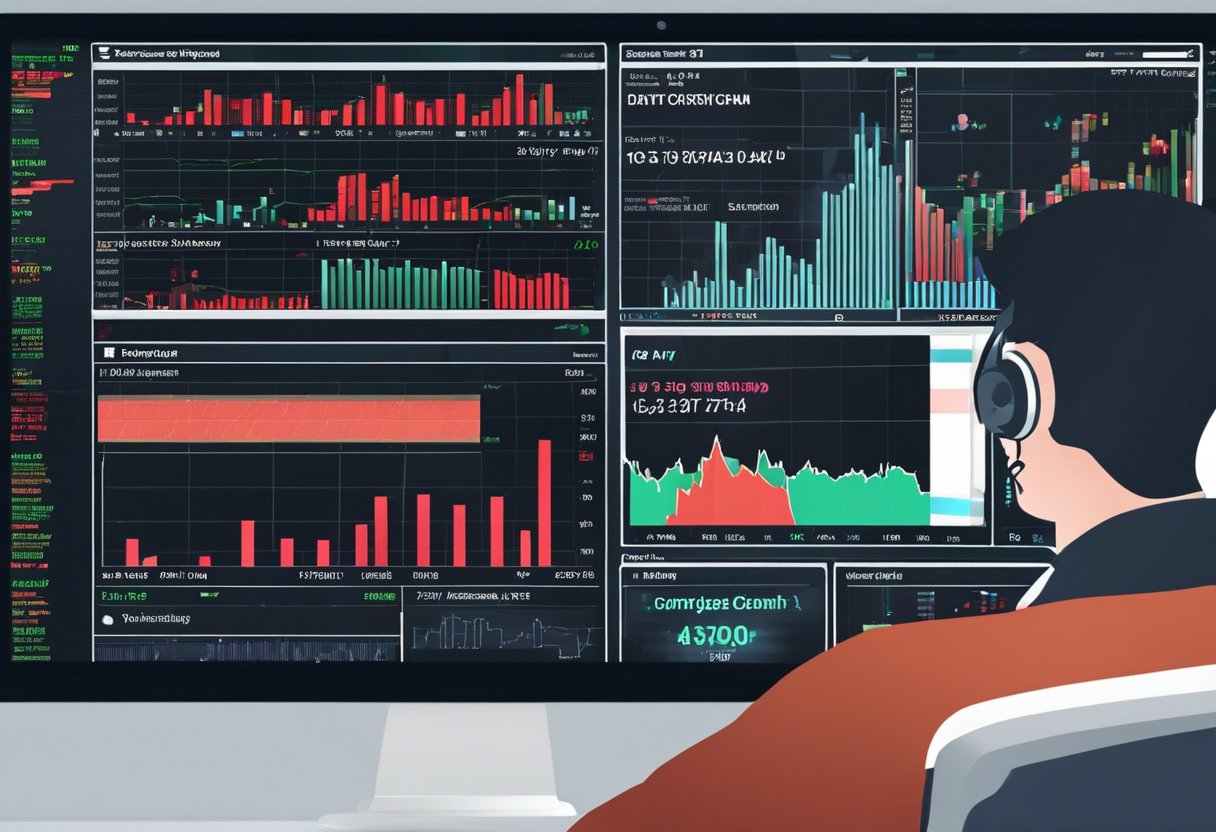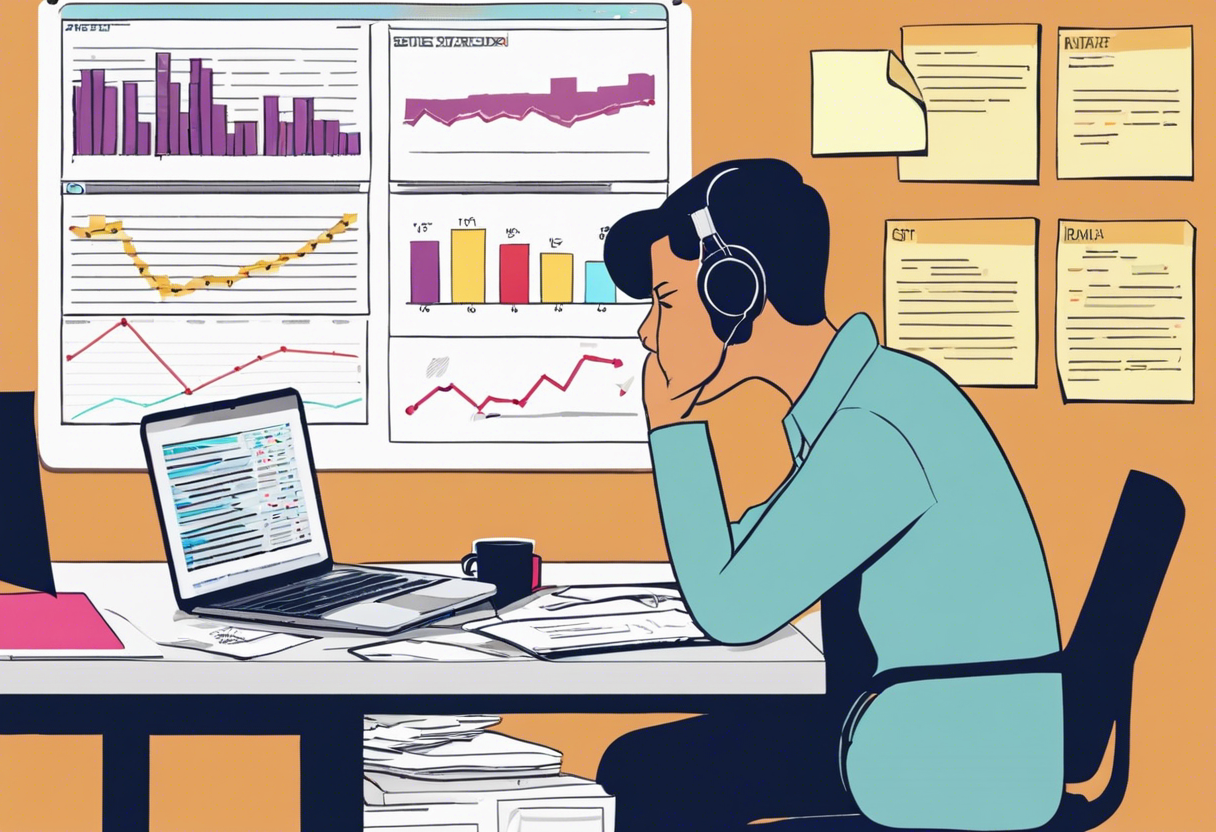Mastering Risk Management in Day Trading
Effective risk management in day trading is the key to success and longevity in the market. It involves strategies like setting clear risk-reward ratios, using stop-loss orders, diversifying trades, and adhering to a well-defined trading plan to minimize losses and preserve capital. These practices help navigate the unpredictable nature of financial markets, protecting traders from significant losses and enhancing their chances of profitability. This article explores these crucial risk management principles and techniques, essential for both novice and experienced day traders.
- Understanding the Importance of Risk Management
- Identifying the Potential Risks in Day Trading
- Developing a Solid Trading Plan
- Setting Realistic Goals and Expectations
- Implementing Risk-Reducing Strategies
- Managing Emotions and Psychological Factors
- Continuous Monitoring and Evaluation
- Learning from Past Mistakes and Adjusting Strategies
Understanding the Importance of Risk Management In Day Trading
In day trading, risk management is crucial for ensuring long-term success and protecting your capital. As a day trader, I understand the significance of implementing effective risk management strategies to minimize potential losses and maximize profits. This section will delve into the importance of risk management and why it should be a top priority for any day trader.
Protecting Capital
One of the primary reasons why risk management is essential in day trading is to protect your capital. As a trader, I recognize that maintaining and preserving my trading capital is of utmost importance. By implementing proper risk management techniques, I can limit the amount of money I put at risk in any given trade. This helps to safeguard my capital and prevent significant losses that could wipe out my account.
Minimizing Losses
Effective risk management also helps to minimize losses. Day trading can involve a certain degree of volatility and uncertainty, making it essential to prepare for potential losses. By setting strict stop-loss orders and adhering to them, I can limit the amount of money I am willing to lose on a trade. This approach ensures that even if a trade goes against me, the potential loss is controlled and within my predefined risk tolerance.
Maximizing Profits
Risk management is not just about limiting losses; it also plays a vital role in maximizing profits. By employing proper risk-to-reward ratios, I can identify trades that offer favorable profit potential while maintaining a controlled level of risk. This allows me to capitalize on profitable opportunities while minimizing the impact of losing trades.
Emotion Management
An often-overlooked aspect of risk management in day trading is the role it plays in managing emotions. Volatility in the markets can trigger strong emotions such as fear or greed, which can lead to impulsive and irrational trading decisions. By adhering to a well-defined risk management plan, I can maintain a disciplined and objective approach to trading, regardless of the market conditions. This helps to mitigate emotional decision-making, ensuring that my trading decisions are based on logic and strategy rather than emotions.
Long-Term Sustainability
Ultimately, effective risk management is vital for long-term sustainability in day trading. By carefully managing risk and preserving capital, I can endure market fluctuations and sustain my trading activities over time. This allows me to weather the ups and downs of the market without jeopardizing my trading career. By prioritizing risk management, I can increase my chances of achieving consistent profits and achieving my long-term trading goals.
To summarize, risk management is of utmost importance in day trading. It helps protect capital, minimize losses, maximize profits, manage emotions, and ensure long-term sustainability. As a proactive day trader, I understand the significance of implementing effective risk management techniques to navigate the dynamic and volatile nature of the markets. By prioritizing risk management, I can increase my chances of success and build a solid foundation for my day trading journey.
Identifying the Potential Risks in Day Trading
In day trading, it is crucial to be aware of the potential risks in order to effectively manage them and minimize potential losses. Here, I will discuss some of the main risks that day traders may encounter during their trading activities.
Market Volatility:
One of the primary risks in day trading is market volatility. This refers to the rapid and significant price changes in financial markets. Volatile markets can result in increased trading activity and heightened price fluctuations, presenting both opportunities and risks for day traders. While volatility can provide chances for profit, it can also amplify losses if trades are not carefully executed. Therefore, it is important for day traders to be able to adapt to changing market conditions and have appropriate risk management strategies in place.
Lack of Knowledge and Experience:
Day trading requires a solid understanding of financial markets, trading strategies, and technical analysis. As a trader, I must be aware that lack of knowledge and experience can expose me to considerable risks. Without proper knowledge, it can be challenging to identify potential opportunities or accurately assess market trends. It is important to continuously educate myself about different trading strategies, stay updated with market news, and practice with virtual trading accounts to gain valuable experience before risking real capital.
Emotional Decision Making:
Emotions can have a significant impact on trading decisions, and this is a risk that many day traders face. Fear and greed are two common emotions that can cloud judgment and lead to impulsive trading decisions. It is crucial to recognize and control these emotions to avoid making poor trading choices driven by fear or excessive greed. I need to develop a disciplined approach to trading, stick to my predetermined trading plan, and avoid making impulsive decisions based on emotions.
Lack of Risk Management In Day Trading:
Failure to implement proper risk management strategies is a major risk in day trading. Without effective risk management, I may expose myself to larger losses and potentially wipe out my trading account. I should determine my risk tolerance levels, set stop-loss orders to limit potential losses, and diversify my trading portfolio to mitigate risks. Additionally, I need to be aware of the amount of capital I allocate to each trade and avoid overexposing myself to a single trade or sector.
Technical Issues and Connectivity Problems:
Technical issues and connectivity problems can pose significant risks to day traders. A slow internet connection or platform malfunctions can result in delayed or missed trade executions, leading to potential losses or missed opportunities. It is crucial to have a reliable and robust trading platform, maintain a stable internet connection, and regularly monitor and troubleshoot any technical issues that may arise. I need to have a backup plan in case of connectivity problems, such as having a mobile trading app or alternative internet source.
Regulatory and Legal Risks:
Day traders need to be aware of the regulatory and legal risks associated with their trading activities. Trading regulations and laws vary across different jurisdictions, and violating these rules can lead to penalties or legal consequences. It is crucial to understand and comply with the applicable trading regulations, such as margin requirements, insider trading restrictions, and tax obligations. Staying informed about regulatory changes and seeking professional advice when needed can help me navigate the legal landscape of day trading.
Being aware of these potential risks allows me to develop effective risk management strategies, minimize losses, and increase the chances of achieving profitable trades. By continuously educating myself, controlling emotions, implementing risk management techniques, and staying in compliance with regulations, I can enhance my overall success as a day trader.
Developing a Solid Plan For Risk Management In Day Trading
Creating a well-defined trading plan is crucial for successful day trading. It serves as a roadmap for executing trades and helps to minimize risk. Here are some essential elements to consider when developing your trading plan:
1. Identify Your Goals and Objectives
Before diving into day trading, take the time to identify your goals and objectives. Consider what you hope to achieve and how day trading fits into your overall financial strategy. Are you looking to generate a consistent income or build long-term wealth? Defining your goals will help shape your trading plan and guide your decision-making process.
2. Determine Your Risk Tolerance
Understanding your risk tolerance is vital in day trading. Assess how much loss you can comfortably handle without it affecting your emotional well-being or financial stability. Be realistic and honest with yourself, as taking on too much risk can lead to emotional decision-making and impulsive trades. Setting a maximum risk threshold will help you avoid unnecessary losses.
3. Define Your Trading Strategy
Developing a solid trading strategy is the cornerstone of a successful trading plan. Consider which trading style best suits your personality and risk appetite. Are you more inclined towards scalping, day trading, swing trading, or position trading? Each style has its own advantages and requires a different approach. Determine the indicators and technical analysis tools you will use to identify entry and exit points. It’s important to backtest your strategy and refine it over time based on your trading results.
4. Set Your Entry and Exit Rules
Establish clear rules for entering and exiting trades. Define the criteria that need to be met for a trade to be executed, such as specific price levels, technical indicators, or market conditions. Also, determine your exit strategy, which can include setting profit targets and stop-loss orders to protect against losses. Consistently following your entry and exit rules will help you stay disciplined and avoid emotional decision-making.
5. Manage Your Position Sizing
Position sizing refers to determining the appropriate amount of capital to allocate to each trade. It’s important to manage your position size according to your risk tolerance and the specific trade setup. Avoid putting too much capital into a single trade, as it can expose you to significant losses. Implement risk management techniques, such as using a fixed percentage of your trading capital per trade, to ensure you maintain a balanced and sustainable approach.
6. Keep a Trading Journal
Maintaining a trading journal is a valuable practice for day traders. It allows you to track and review your trades, identify patterns, and learn from both successes and failures. Your trading journal should include details such as entry and exit points, trade rationale, and emotional state at the time of the trade. Regularly reviewing your journal will provide insights into your trading performance and help refine your trading plan.
7. Continuously Educate Yourself
The trading landscape is constantly evolving, and it’s essential to stay up-to-date with market trends, economic news, and changes in trading strategies. Dedicate time to ongoing education and stay engaged with trading communities, books, courses, and webinars. Continuously educating yourself will enhance your knowledge and skills, ultimately improving your decision-making ability and trading performance.
By developing a solid trading plan that incorporates these essential elements, you will be better equipped to manage risk, maintain discipline, and increase your chances of success in day trading. Remember, consistency and adaptability are key, and continuous refinement of your plan is necessary as you gain experience and navigate the dynamic nature of the markets.
Setting Realistic Goals and Expectations For Proper Risk Management In Day Trading
In day trading, it is crucial to set realistic goals and expectations for yourself. This helps to ensure that you have a clear focus and can make informed decisions based on your desired outcomes. Here are some key considerations when setting goals and expectations in day trading:
- Define your objectives: Before you begin day trading, take the time to define your objectives. Ask yourself why you want to engage in day trading and what you hope to achieve. Whether it is generating additional income, building wealth, or gaining financial independence, clearly outlining your goals will help guide your trading strategy.
- Set achievable targets: While it’s great to have big aspirations, it’s important to set achievable targets. Setting unrealistic goals can lead to frustration and disappointment. Instead, break down your overall objectives into smaller, manageable targets. This way, you can track your progress and celebrate small victories along the way.
- Consider your risk tolerance: Day trading involves inherent risks, and it’s crucial to assess your risk tolerance. Be honest with yourself about how much you are willing to risk financially and emotionally. Setting goals that align with your risk tolerance will help you maintain a balanced approach to trading and minimize the potential for significant losses.
- Be aware of market conditions: Day trading is influenced by market conditions, and it’s important to consider them when setting goals and expectations. Volatile markets may offer more trading opportunities but also come with increased risk. On the other hand, stable markets may have fewer opportunities but are generally considered less risky. Factoring in market conditions allows you to align your goals and expectations with the current trading environment.
- Manage your time effectively: Set realistic expectations regarding the time you can dedicate to day trading. Consider your other commitments and responsibilities and determine how much time you can realistically allocate to trading activities. Trying to trade when you have limited time available can lead to impulsive decisions and increased stress. By managing your time effectively, you can maintain a disciplined and focused approach to trading.
- Continuously review and adapt: Day trading is a dynamic activity, and it’s essential to continuously review and adapt your goals and expectations. Regularly assess your progress, evaluate your trading strategies, and make any necessary adjustments. This ongoing review process ensures that your goals remain realistic and align with your evolving knowledge and experience as a day trader.
In conclusion, setting realistic goals and expectations is a fundamental aspect of effective risk management in day trading. By defining your objectives, setting achievable targets, considering your risk tolerance, being aware of market conditions, managing your time effectively, and continuously reviewing and adapting, you can position yourself for success and minimize unnecessary risks.
Implementing Risk-Reducing Strategies for Risk Management In Day Trading
To effectively manage risk in day trading, it is crucial to have a set of strategies in place that can help minimize potential losses. These risk-reducing strategies can be implemented to protect capital and improve overall trading performance. In this section, I will discuss some key strategies that I find helpful in managing risk effectively.
-
Setting Stop Loss Orders:
One of the most important risk-reducing strategies in day trading is setting stop loss orders. A stop loss order is an instruction given to the broker to sell a security if it reaches a specified price level. By setting a stop loss order, I can limit the amount of money I am willing to lose on a trade. This helps to prevent emotions from taking over during volatile market conditions and ensures that I exit a trade if it is moving against me.
-
Using Trailing Stop Loss Orders:
In addition to setting regular stop loss orders, I also make use of trailing stop loss orders. A trailing stop loss order is a type of order that adjusts the stop price as the market price of the security changes. This allows me to lock in profits as the trade moves in my favor while also providing downside protection. Trailing stop loss orders help me secure gains and limit potential losses, especially in fast-moving markets.
-
Diversifying the Portfolio:
Another risk-reducing strategy that I employ is diversifying my trading portfolio. Diversification involves spreading investments across different asset classes, sectors, or trading strategies. This helps to reduce the impact of a single trade or market event on my overall portfolio. By diversifying, I can potentially reduce risk and improve the likelihood of achieving consistent profits. I carefully consider different trading opportunities and select a mix of assets that have low or negative correlations to minimize portfolio volatility.
-
Using Proper Position Sizing:
Proper position sizing is crucial in managing risk effectively. It involves determining the appropriate amount of capital to allocate to each trade based on the potential risk and reward. I never risk more than a predetermined percentage of my trading capital on any single trade. By using proper position sizing, I can control the amount of capital exposed to risk and avoid excessive losses. This strategy helps to protect my trading capital and preserves it for future opportunities.
-
Employing Risk-Reward Ratio:
Using a risk-reward ratio is another valuable strategy in day trading. This ratio considers the potential reward in relation to the potential risk of a trade. It helps me identify trades where the potential reward outweighs the potential risk, increasing the probability of profitable trades. By maintaining a positive risk-reward ratio, I can afford to have more losing trades while still being profitable overall.
-
Constantly Monitoring and Reviewing Trades:
Finally, constant monitoring and reviewing of trades are essential risk management strategies. By regularly monitoring my trades, I can quickly identify any deviations from my trading plan and take appropriate actions. I regularly review my trading performance to identify strengths, weaknesses, and areas for improvement. This allows me to learn from past mistakes, refine my strategies, and continuously improve my risk management practices.
In conclusion, implementing risk-reducing strategies is crucial in day trading to protect capital and enhance overall trading performance. By setting stop loss orders, using trailing stop loss orders, diversifying the portfolio, employing proper position sizing, considering risk-reward ratio, and monitoring and reviewing trades, I can effectively manage risk and achieve consistent profits in the dynamic world of day trading.
Risk Management In Day Trading Emotions and Psychological Factors
As a day trader, managing emotions and psychological factors is crucial for effective risk management. The fast-paced nature of day trading can trigger intense emotions such as fear, greed, and impatience, which can lead to irrational decision-making and increased risk. Therefore, it is essential to develop strategies to manage these emotions and maintain a disciplined approach to trading.
1. Self-awareness:
The first step in managing emotions is to develop self-awareness. Understanding our emotional triggers and how they affect our decision-making process is crucial. Self-reflection and journaling can help identify patterns and reactions that may lead to impulsive or irrational trades. By recognizing these triggers, I can take proactive steps to manage them.
2. Stress management:
Stress can have a significant impact on trading performance. High-stress levels can impair judgment and increase the likelihood of making poor decisions. To effectively manage stress, I prioritize self-care and stress reduction techniques such as regular exercise, meditation, and adequate sleep. Taking breaks during trading sessions and engaging in relaxing activities can also help reduce stress levels and improve decision-making.
3. Maintaining discipline:
Discipline is key to successful day trading. It involves sticking to a well-defined trading plan and following predefined rules. By setting clear entry and exit points for trades, I can minimize the influence of emotions on decision-making. Additionally, I avoid impulsive trading and focus on implementing the strategies I have planned. The ability to stay disciplined in the face of market fluctuations is imperative for managing risk effectively.
4. Setting realistic expectations:
Unrealistic expectations can lead to emotional turmoil and poor trading outcomes. It is essential to set realistic goals and understand that day trading is a marathon, not a sprint. By maintaining realistic expectations, I can reduce the pressure and frustration that may arise from not meeting overly ambitious goals. This helps in maintaining emotional balance and making rational decisions based on market conditions rather than emotional reactions.
5. Seeking support and feedback:
Seeking support from experienced traders and mentors can be highly beneficial. Interacting with fellow traders can provide valuable insights and perspectives on managing emotions and psychological factors. Sharing experiences and seeking feedback can help identify blind spots and areas for improvement. Joining trading communities and participating in educational programs can also create a supportive network of like-minded individuals who understand the challenges of day trading.
6. Continuous learning and adaptation:
Day trading is a dynamic field, and the market conditions are constantly changing. It is crucial to remain open to learning and adapting strategies as necessary. By staying updated on market trends, economic indicators, and news, I can make informed decisions and adjust my trading approach accordingly. Continuous learning helps in building confidence and reducing anxiety, thereby improving risk management and overall trading performance.
In conclusion, effective risk management in day trading requires actively managing emotions and psychological factors. Developing self-awareness, managing stress, maintaining discipline, setting realistic expectations, seeking support, and continuous learning are essential strategies for effectively managing emotions and improving decision-making. By implementing these strategies, I can enhance my trading skills, reduce risk, and increase the likelihood of successful outcomes in day trading.
Continuous Monitoring and Evaluation To Develop Your Risk Management In Day Trading
In day trading, continuous monitoring and evaluation of trades and market conditions are crucial for effective risk management. As a day trader, I understand the importance of staying vigilant and adaptive to ensure profitability and minimize losses. In this section, I will discuss the key aspects of continuous monitoring and evaluation and how they contribute to successful risk management in day trading.
- Real-Time Market Analysis: To effectively manage risk, it is essential to keep a close eye on market trends and price movements in real-time. I regularly analyze market charts, technical indicators, and news updates to identify potential trading opportunities and assess the risk associated with each trade. By staying up-to-date with the latest market information, I can make informed decisions and adjust my trading strategies accordingly.
- Trade Monitoring: Once a trade is executed, I continuously monitor its progress to evaluate the risk-reward ratio. I set stop-loss orders to limit potential losses and adjust them as needed based on market conditions. Additionally, I keep track of key support and resistance levels to identify potential exit points or profit targets. Regularly monitoring trades allows me to assess their performance and make necessary adjustments to minimize risks and maximize profits.
- Risk Assessment: Evaluating the risk associated with each trade is essential for effective risk management. I consider various factors such as market volatility, liquidity, and the potential impact of economic news releases before entering a trade. By assessing the risk level, I can determine the appropriate position size and adjust my trading strategy accordingly. Continuous risk assessment throughout the trading day helps me avoid excessively risky trades and focus on those with a higher probability of success.
- Performance Evaluation: Regularly evaluating my trading performance is vital for continuous improvement and risk management. I maintain a detailed trading journal where I record all my trades, including entry and exit points, profit and loss amounts, and the reasoning behind each trade. By reviewing this journal, I can identify patterns, strengths, and weaknesses in my trading strategy. This self-reflection allows me to make necessary adjustments, learn from past mistakes, and refine my risk management approach.
- Adapting to Market Conditions: The financial markets can be dynamic, with rapid shifts in trends and volatility. To effectively manage risks, I need to be agile and adapt to changing market conditions. I regularly reassess my trading strategies, techniques, and risk tolerance to ensure they align with the current market environment. Being flexible and open to adjusting my approach allows me to mitigate risks and take advantage of emerging opportunities.
In conclusion, continuous monitoring and evaluation are crucial components of effective risk management in day trading. By staying proactive, vigilant, and adaptable, I can identify potential risks, assess their impact, and make informed decisions to manage and minimize them. Regular evaluation of my trading performance and risk mitigation strategies allows me to refine my approach and enhance long-term profitability. As a day trader, I understand that continuous improvement and risk management go hand in hand, ensuring consistent success in the dynamic world of day trading.
Learning from Past Mistakes and Adjusting Strategies To Improve Your Risk Management In Day Trading
In day trading, effective risk management hinges on learning from past mistakes and adapting strategies. Keeping a detailed trading journal helps identify patterns and recurring errors, such as impulsive decisions leading to losses. Regular review of this journal and conducting post-trade analysis are critical for understanding decision-making flaws and adjusting strategies. Staying informed about market news and developments is essential to adapt to changing market dynamics. Continuous education through reading, seminars, and forums enhances trading knowledge and skills, helping to avoid repeating past mistakes. Overall, the ability to learn and adapt is crucial for long-term success in the dynamic world of day trading.
If you would like to take your trading to the next level, then click on the link below, follow the instructions, and checkout the free training.









